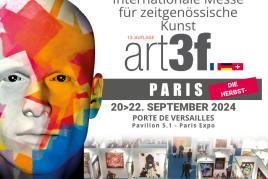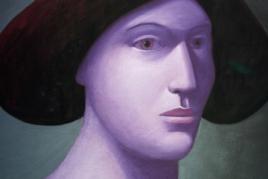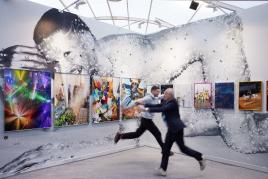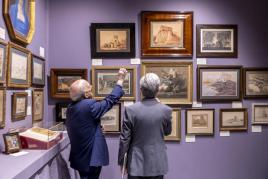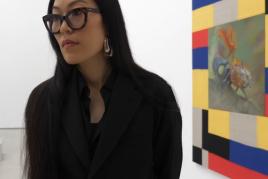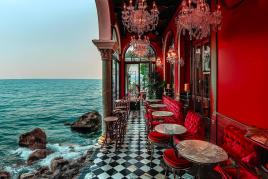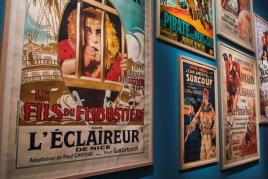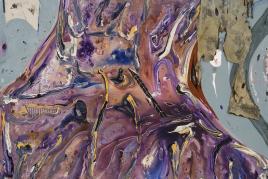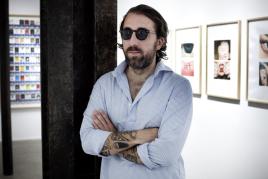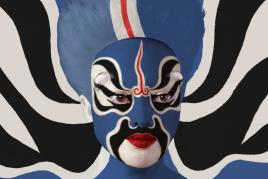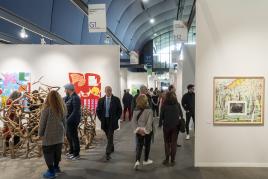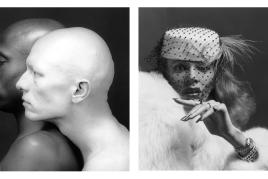This September, Galerie Thaddaeus Ropac is delighted to be showing A Focus on Painting, curated by Julia Peyton- Jones. The exhibition features four artists from different generations and at different points in their careers – Alvaro…
A FOCUS ON PAINTING
 Alvaro Barrington. Courtesy the artist. Photo: Robert Glowacki. - Mit freundlicher Genehmigung von: ropac
Alvaro Barrington. Courtesy the artist. Photo: Robert Glowacki. - Mit freundlicher Genehmigung von: ropacWer: ropac
Was: Ausstellung
Wann: 12.09.2020 - 21.10.2020
Wo: Paris, Frankreich
This September, Galerie Thaddaeus Ropac is delighted to be showing A Focus on Painting, curated by Julia Peyton- Jones. The exhibition features four artists from different generations and at different points in their careers – Alvaro Barrington, Mandy El-Sayegh, Rachel Jones and Dona Nelson – three of whom have never previously exhibited at Galerie Thaddaeus Ropac.The individual artists’ presentations throughout the gallery demonstrate some of the wide-ranging possibilities of painting today. They explore themes such as the formation of identity, the communication of meaning and the subjectivity of interpretation, as well as the boundaries between personal expression and collective experience.
With materials ranging from yarn to newsprint to poured colour, the processes these artists use and the forms of their final works are compellingly diverse. Mandy El-Sayegh and Rachel Jones explore what appears to be abstraction, however at its core is an investigation of the human body and the formation of identity, while Alvaro Barrington and Dona Nelson play with form and materials not usually associated with painting.
For this exhibition, Alvaro Barrington has created a series that engages with his relationship to the history of painting. He references the linear concept of the gallery’s hallway and the line as a tool of making that, in Barrington’s works, evokes both a physical journey as well as the intersecting strands formed through the action of weaving.Mandy El-Sayegh’s installation, which includes a ‘rug’ on the hand-laid latex floor, investigates the possibilities of materials and language through the layering of found images and text. El-Sayegh employs the grid as a structure to weave together disparate remnants of memory, history and discourse.
Although Rachel Jones has eliminated any literal depiction of self or the body, her work is a continual exploration of form as an expression of abstract concepts. The barely discernible presence of a mouth or teeth act as signifiers for the body as a whole, rendered in a bold palette and rich textures.Dona Nelson allows chance to influence the final composition, working on both sides of the canvas so there is no ‘right side’ from which to view the finished painting. The final work is often exhibited on a stand, as opposed to hung on the wall, blurring the lines between painting and sculpture.It is very exciting to look at the work of four painters, from the established to the emerging, and to see how each engages with the medium in widely different ways. Alvaro Barrington has created two new pieces comprising thread, paint and burlap, one of which is made up of numerous parts; Mandy El-Sayegh has conceived an all- embracing installation across the gallery's walls and floor; Dona Nelson blurs the lines between painting and sculpture; while at the core of Rachel Jones's seemingly abstract work the representation of the body is explored through exuberant colours and textured surfaces. – Julia Peyton-Jones, 2020
ALVARO BARRINGTONAlvaro Barrington (b. 1983, Caracas, Venezuela) has risen to international acclaim in recent years with his multidimensional practice ranging from solo presentations of his work to collaborative street parties, concerts and floats for Notting Hill Carnival. He is currently teaching at Slade School of Fine Art in London and will have a solo exhibition at Galerie Thaddaeus Ropac, Paris in Spring 2021.
Barrington presents two new paintings conceived specifically for this exhibition and informed by an ongoing commitment to a wide range of practices – including the visual arts, music, fashion, education and philanthropy. Experimenting with and adjusting to the ‘logic’ found within other artists’ work in relation to his own, these new works consider different approaches to abstraction through simplified palettes, the application of the grid and the expressive potential of bold brushstrokes.When you look at my paintings, you’re encountering parts of my identity. I grew up in a culture where it was really about erasing hierarchies, where we’re all participating in cultural production. – Alvaro BarringtonPainted in the artist’s London studio during lockdown, these works continue Barrington’s interest in dialogue, interpersonal histories and the logic of abstraction, expanding his reflections on and embrace of contemporary digital culture and his ongoing interest in music. Using torn sheets of burlap as canvas and presented in custom- made wooden frames, the works reference the artist's personal and cultural ties to the Caribbean, where cacao beans are packed in burlap bags, while their woven structure offers a physical representation of the intricacies of the ever-expanding World Wide Web.
Barrington’s new paintings reflect on the intricate relationship between painting and digital: painters have explored the ‘flat’ surface for thousands of years and, as such, have the potential to significantly influence future developments in the digital realm, accessed through the flat surface of a screen. The works trace a particular mode of working through the practices of Barrington’s predecessors – namely, Brice Marden (b. 1938) and American Minimalism – obliquely referenced by the date ranges that give his works their titles. In one piece, consisting of a number of Date Paintings in green tones, Barrington works directly with the gallery architecture to consider painting’s ability to react to and interrupt the tempo of a space and, in doing so, to influence visitors’ experience of a building and their movement through it. Installed throughout the corridor of Ely House, the monochrome paintings interrogate the kinaesthetic qualities of colour, size and placement, as well as relationships between vision, sound and movement.
It's about using colour and size as a push / pull ... You get used to seeing the same thing and then all of a sudden, a different tempo hits. – Alvaro Barrington
MANDY EL-SAYEGHLondon-based Mandy El-Sayegh (b. 1985, Selangor, Malaysia) had her first institutional solo show, the specially commissioned installation Cite Y our Sources, at London’s Chisenhale Gallery last year. She was shortlisted for the biannual Max Mara Art Prize for Women in collaboration with the Whitechapel Gallery, London in 2017.The artist presents an immersive installation featuring monumental paintings and assemblage, transforming the gallery's interior through direct interventions to the walls and floor. El-Sayegh’s practice explores the constant flux of meaning, constructed through the production and circulation of images and texts, and their subjective interpretation, with a focus on language and the body.
I’m interested in the erasure of meaning, or the accumulation of meaning through a layering system. – Mandy El-SayeghCombining found fragments with imagery and text, including advertisements, pages from the Financial Times, anatomical illustrations, collected sketches, hand-painted gestures and Arabic calligraphy borrowed from her father, El-Sayegh creates fleshy, visceral works that reconfigure seemingly abstract elements into a unified whole. Permeated by associative logic, these explorations of material and language take form in anthological collections of imagery and text, large-scale wall works, and all-encompassing, site specific installations.
Plastering newspapers across the gallery floor, El-Sayegh intervenes directly with the architecture of the space with the site-specific installation, gravity as fiction (2020). Bound between layers of latex, her interventions suggest medical associations and, in turn, point to the skin as an encasing structure for the multifarious thoughts, feelings and pieces of information that are absorbed and internalised daily. Upending the traditional notion of a frame, the latex alludes to the human need to make sense of the experiences and information to which we are repeatedly exposed, or which we have internalised through inheritance and transference. This notion of corporeality forms a crucial structuring principle in the artist’s work: she refers to her collage process as ‘suturing’ – the surgical act of stitching a wound – and to her painted surfaces as ‘skins’. In this installation, the understanding of a definitive truth is decentralised, while the viewers’ immersion in the totalising display reflects the human position as innately bound within multiple systems of structures and signs.
In her Net-grid paintings, El-Sayegh overlays silkscreen prints combining personal memorabilia, found objects and linguistic elements with hand-painted grids to consider the proliferation of materials and information, as well as the structures that contain them. The painted grids function to simultaneously contain and obscure information. They suggest the cultural and linguistic dislocation experienced in an unfamiliar context or system, whereby fragments of information with no immediate associations are transformed through the illusion of unity.Throughout the installation, El-Sayegh’s sutured ‘skins’ are informed by what she refers to as ‘the scrolling way of seeing’: the passive engagement with social media feeds and the undifferentiated flow of information across our screens. The artist highlights the processes through which meanings become internalised and fragmented. Removed from their original contexts, the texts are reduced to a series of free-floating signifiers with no inherent meaning, taking on new narrative functions beyond their primary intent and drawing attention to the linguistic, cultural or political systems that usually inform their interpretation. By adopting recognisable signifiers and motifs – such as the familiar broadsheet or the fundamentals of text – El-Sayegh interrogates the perceived objectivity of language and the media by severing them from their habitual contexts. Probing the power of cultural and linguistic dislocation, the artist’s display becomes a site of metonymic regeneration – the transformation or biological renewal of ‘metonymy’ – the substitution of associated terms or concepts for one another. It becomes a mode of grafting wounds.
I treat the text script or the citation as a skin, literally and figuratively ... If you don’t have language, you feel it through the body. And then there’s often a form of shrugging off, which always hurts a bit, like the lobster [shedding its shell]. – Mandy El-Sayegh
RACHEL JONESRachel Jones (b. 1991, London, UK) completed her Masters Degree at the Royal Academy Schools last year and was awarded the André Dunoyer de Segonzac Hon RA Prize before exhibiting alongside Gillian Ayres and Nao Matsunaga at the New Art Centre, Salisbury (September – November 2019). Jones has held residencies at both The Chinati Foundation, Marfa, Texas in 2019 and the Masterworks Museum of Bermuda Art, Bermuda in 2016.Jones presents a series of new paintings that explore the complexities of society’s readings of the Black body – how it is understood, how it is culturally reproduced, and the potential role of these representations in dismantling existing power structures. Jones's presentation includes a number of large-scale hanging pieces alongside smaller works on unstretched canvas and paper pinned to the wall.
Jones is interested in creating images that explore the Black Interior, the depth of her own interiority and how, as a Black woman, it consists of an autonomous, imaginary, and multifaceted experience. This exploration of personal identity set against society’s readings (and representations) of Blackness throughout history has led Jones to develop a deeply personal approach to abstraction, whereby representation – particularly of Blackness and the Black body – is explored as both reinforcing existing power structures and as having the power to disrupt them.I try to use colour to describe black bodies. I want to translate all that lust for self-expression into a language that exists outside of words, and instead relates to seeing and feeling with your eyes. – Rachel JonesRather than literally depicting the figures her work seeks to represent, Jones applies a form of critical interpretation to the language of painting, reconsidering both traditional and contemporary approaches to colour, form and motif. In response to these approaches, she explores self-expression as a bodily, visual and visceral experience, not only in the subject-matter of each piece but in the artist’s physical engagement with their production. Jones is interested in eliminating a literal depiction of self, instead focusing on a sense of self in relation to the sovereignty of her inner life and the expression of this through a kaleidoscopic palette and boldness of form.A number of the new works on display feature recurring motifs or symbols such as mouths or teeth, dominated by fiery red tones. These subtle recurrences place the paintings in dialogue with one another and allude to their kinship as part of the artist’s ongoing investigation. Together they present an exploration into the construction of individual or representative identities within an existing system, while simultaneously becoming physical records of different chapters in Jones’s research and her own relationship with representations of self. Developing a unique abstract language, the artist uses colour and form as a way of processing complex existential ideas – the hints of figuration present in her works appear only indicatively, suggesting the limits of depictions of the external (of figuration), when attempting to express the internal (experience and emotion).
For me, it's a matter of being able to explore different ways of making ... to escape the rigidity of working within the structure ... I don't want it to be a comfortable image to take in, so I try to create as much friction as possible, to create a certain level of complexity. – Rachel Jones
DONA NELSONDona Nelson (b. 1947, Grand Island, Nebraska, USA) has an oeuvre spanning fifty years that has been exhibited internationally. Incorporating a variety of approaches to both image and material, Nelson is most recognisable for her two-sided stain paintings, in which the artist works on both sides of a stretched canvas. These characteristic paintings constitute a significant element of Nelson’s ongoing practice and a selection of these large-scale works will be presented in the upcoming exhibition.Dona Nelson has ... proven to be one of the most relentlessly searching, rigorously idiosyncratic, and technically inventive painters alive. Her recent, hypermaterialist field paintings, often translucent, two-sided and suspended in free space, have become landmarks ... for younger painters seeking to extend the experimental possibilities of the New York School. – Brooks Adams, contributing editor, Art in AmericaThroughout her career, Nelson has created gestural abstract works that employ unorthodox materials, processes and formats to disrupt conventional ideas concerning painting, modes of display and ways of looking. Painting ‘en plein air’, the artist approaches the canvas as both a conduit and a ground, using buckets of paint and tools such as spatulas or high pressure hoses to work on her canvases. Nelson begins her two-sided paintings by throwing a net of gel-soaked cheesecloth onto the canvas, which dries to form linear grooves that direct the flow of the liquid acrylic that she pours on, before repeating the process and then removing or adding elements in turn. The direct pour of diluted acrylic paint acquires a new and unexpected appearance as it soaks through the canvas to the other side. As a result, one side of the painting often has a denser materiality, while the other takes on an illusionistic and imagistic quality.
Ripped, layered and interwoven with painted string, the finished paintings bear testament to their production, retaining traces of the artist's actions and the energetic, physical movements through which she produces each piece. Protruding cheesecloth, dense drips of paint and thickly woven string emerge and disappear into the canvas – the physical additions of the creative act – while torn edges and traces of cloth that has been removed take on a gestural absence – the creative act embodied in negative space.While referred to as having a ‘front’ (recto) and a ‘back’ (verso), Nelson works on both sides of the canvas repeatedly and in tandem, denying the priority traditionally given to the canvas's ‘front’. Engaging in ongoing acts of intervention, reception and further manipulation, she paints in direct conversation with her materials. Considering herself in dialogue with her work, Nelson rejects the hierarchy of the ruling artist in favour of a participatory process, born from the fundamental belief that all materials have an innate and unique energy to which she responds: ‘Once I see the character of the painting, I get excited, and then what I have to do to finish the painting becomes clear to me. I follow the painting until its character completely emerges from the shadows.’
Rich in depth and texture, the finished works are often exhibited on floor-based steel or wooden constructions instead of hanging flat against the wall, which invites a novel way of viewing by encouraging visitors to walk around the paintings in order to experience them in full.It makes the mental, physical. It asserts vision through the body. You need more effort as a viewer. You cannot be passive. – Dona Nelson
.
Copyright © 2024 findART.cc - All rights reserved

